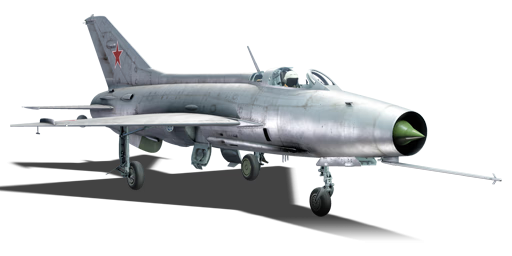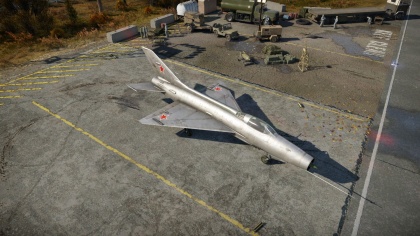MiG-21F-13
Contents
| This page is about the Russian jet fighter MiG-21F-13. For Chinese licsense built version, see J-7II. |
Description
The MiG-21F-13 is a rank VI Russian jet fighter
with a battle rating of 8.7 (AB), 9.3 (RB), and 9.7 (SB). It was introduced in Update 1.91 "Night Vision".
General info
Flight performance
Describe how the aircraft behaves in the air. Speed, manoeuvrability, acceleration and allowable loads - these are the most important characteristics of the vehicle.
| Characteristics | |||||||
|---|---|---|---|---|---|---|---|
| Stock | |||||||
| Max Speed (km/h at 13,000 m) |
Max altitude (meters) |
Turn time (seconds) |
Rate of climb (meters/second) |
Take-off run (meters) | |||
| AB | RB | AB | RB | AB | RB | ||
| ??? | ??? | 16000 | ??.? | ??.? | ??.? | ??.? | 750 |
| Upgraded | |||||||
| Max Speed (km/h at 13,000 m) |
Max altitude (meters) |
Turn time (seconds) |
Rate of climb (meters/second) |
Take-off run (meters) | |||
| AB | RB | AB | RB | AB | RB | ||
| ??? | ??? | 16000 | ??.? | ??.? | ??.? | ??.? | 750 |
Details
| Features | ||||
|---|---|---|---|---|
| Combat flaps | Take-off flaps | Landing flaps | Air brakes | Arrestor gear |
| ✓ | ✓ | ✓ | ✓ | X |
| Limits | ||||
|---|---|---|---|---|
| Wing-break speed (km/h) |
Gear limit (km/h) |
Combat flaps (km/h) |
Max Static G | |
| + | - | |||
| 550 | ~11 | ~5 | ||
| Optimal velocities | |||
|---|---|---|---|
| Ailerons (km/h) |
Rudder (km/h) |
Elevators (km/h) |
Radiator (km/h) |
| < 650 | < 600 | < 780 | N/A |
| Compressor (RB/SB) | ||
|---|---|---|
| Setting 1 | ||
| Optimal altitude | 100% Engine power | WEP Engine power |
| 0 m | 3,350 kgf | 5,025 kgf |
Survivability and armour
Examine the survivability of the aircraft. Note how vulnerable the structure is and how secure the pilot is, whether the fuel tanks are armoured, etc. Describe the armour, if there is any, and also mention the vulnerability of other critical aircraft systems.
Armaments
Offensive armament
Describe the offensive armament of the aircraft, if any. Describe how effective the cannons and machine guns are in a battle, and also what belts or drums are better to use. If there is no offensive weaponry, delete this subsection.
Suspended armament
Describe the aircraft's suspended armament: additional cannons under the wings, bombs, rockets and torpedoes. This section is especially important for bombers and attackers. If there is no suspended weaponry remove this subsection.
Defensive armament
Defensive armament with turret machine guns or cannons, crewed by gunners. Examine the number of gunners and what belts or drums are better to use. If defensive weaponry is not available, remove this subsection.
Usage in battles
Describe the tactics of playing in the aircraft, the features of using aircraft in a team and advice on tactics. Refrain from creating a "guide" - do not impose a single point of view, but instead, give the reader food for thought. Examine the most dangerous enemies and give recommendations on fighting them. If necessary, note the specifics of the game in different modes (AB, RB, SB).
Pros and cons
Pros:
- Great top speed
- Has access to air-to-air missiles
- Hard-hitting 30 mm cannon
- Decent manoeuvrability at high speeds
- Great rate of climb
- Fairly small target
Cons:
- Low-speed manoeuvrability is not very good
- Only one gun
- Measly 60 rounds of ammo; you must make every shot count
- Quirky rudder characteristics
- Missiles have a short lock-on range
- Can exceed wing rip speed (1,300 kph) in level flight
History
The MiG-21 series of planes would become the most widely-used family of fighter jets in the world, with over 4,000 produced, including license-built copies in China, India and Czechoslovakia. The roots of this highly successful combat aircraft started in the mid-1950s, with the Soviet desire to create a Mach-2 capable light fighter. The first MiG-21F prototypes were presented at the Tushino air show in June 1956, and deliveries started in 1958. The model, "Fishbed C" in NATO parlance, was widely exported. In the Soviet Union, it was replaced by the MiG-21PF model after 1961.
Devblog
Development of the MiG-21 dates back to the early 1950s, when the Mikoyan design bureau was conducting development work on a design study for a new swept-wing jet aircraft. Further work on the project led to the creation of a seperate, delta wing prototype, designated ‘Ye-4’. With test flights showing promising results, but also much room for improvement, work on the Ye-4 resumed. Further tweaks and modifications to the design eventually lead to the Ye-5 prototype, which conducted its maiden flight in January 1956.
During testing, the Ye-5 received its new designation ‘MiG-21’ and was officially ordered into production. However, production of this initial batch of MiG-21s was rather short, with only a handful of machines being built. In the meantime, an improved version of the aircraft - the Ye-6 - was being worked on. By May 1958, testing of the Ye-6 was deemed to be completed. Shortly afterwards, in July, the Ye-6 was ordered into mass production under the designation MiG-21F and was to replace the initial MiG-21 as the standard production model. The aircraft weaponry consists of two 30 mm automatic cannons. The next step was to equip the aircraft with guided “air-to-air” missiles but in to do this one of the cannons had to be removed.
From there on, the MiG-21 would go on to be produced in enormous numbers and in various different variants, both for the needs of the Soviet Union, as well as for export. Around 60 countries have or still use the MiG-21 in various capacities and modifications today.
Well over 11,000 MiG-21s have been produced, including licence-built versions (more than 2,400 models were built in China under the J-7 designation), since the start of production in 1959, with the legendary ‘Fishbed’ becoming the most mass produced combat aircraft since the Korean War and taking part in more armed conflicts than a single devblog would ever be able to cover. But as an example we can mention its participation in the Vietnam War where the MiG-21 was able to push back against the latest U.S. aircraft (which were in majority).
Media
Excellent additions to the article would be video guides, screenshots from the game, and photos.
See also
Links to the articles on the War Thunder Wiki that you think will be useful for the reader, for example:
- reference to the series of the aircraft;
- links to approximate analogues of other nations and research trees.
External links
| USSR jet aircraft | |
|---|---|
| Bereznyak-Isayev | BI |
| Yakovlev | Yak-15 · Yak-15P · Yak-17 · Yak-23 · Yak-28B · Yak-30D · Yak-38 · Yak-38M · Yak-141 |
| Mikoyan-Gurevich | MiG-9 · MiG-9 (l) · MiG-15 · MiG-15bis · MiG-15bis ISh · MiG-17 · MiG-17AS · MiG-19PT |
| MiG-21F-13 · MiG-21PFM · MiG-21S (R-13-300) · MiG-21SMT · MiG-21bis | |
| MiG-23M · MiG-23ML · MiG-23MLD · MiG-27M · MiG-27K | |
| MiG-29 · MiG-29SMT | |
| Lavochkin | La-174 · La-15 · La-200 |
| Sukhoi | Su-9 · Su-11 |
| Su-7B · Su-7BKL · Su-7BMK · Su-17M2 · Su-17M4 · Su-22M3 | |
| Su-24M | |
| Su-25 · Su-25BM · Su-25K · Su-25T · Su-25SM3 · Su-39 | |
| Su-27 · Su-27SM | |
| Su-34 | |
| Ilyushin | IL-28 · IL-28Sh |
| Tupolev | Tu-14T |





